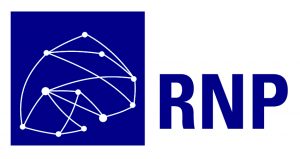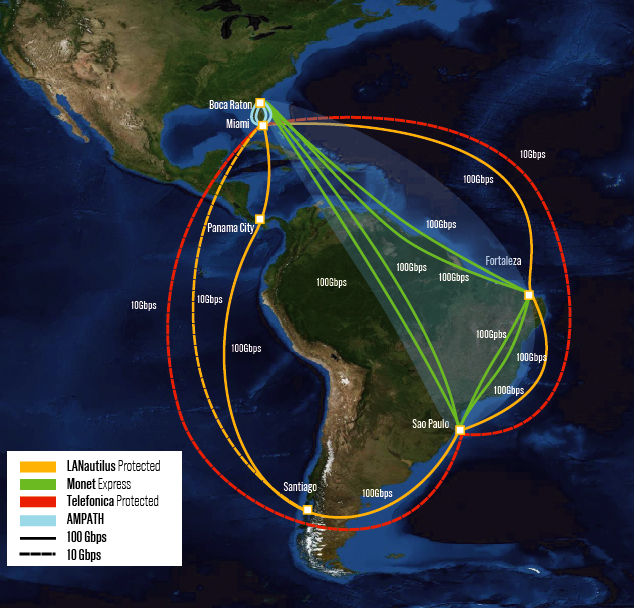


PRESS RELEASE
AmLight Express and Protect project adds three 200Gbps optical waves for Research and Education between the U.S. and Brazil
Miami, Florida, August 30, 2019 – Florida International University (FIU), Rede Nacional de Ensino e Pesquisa (RNP), Academic Network of Sao Paulo (ANSP), the Association of Universities for Research in Astronomy (AURA), and Angola Cables are pleased to announce the addition of three 200Gbps optical waves for research and education between the U.S. and Brazil. These three 200Gbps optical waves represent the Express path of the AmLight Express and Protect (AmLight-ExP) project, a 5-year National Science Foundation (NSF) award to FIU (OAC-1451018), and with support from AURA, and the AmLight Consortium.
The Express path is built upon the Monet submarine cable system, linking the U.S. to Brazil, and operated by Angola Cables. The approach chosen to add these new optical waves was through the use of optical spectrum, where Angola Cables assigned a total of 150GHz over the Monet submarine cable system to be used by the AmLight Consortium. The AmLight Consortium uses the 150GHz spectrum to create three 200Gbps optical waves between Boca Raton, Fortaleza, and Sao Paulo. Each optical wave enables the use of two 100Gbps client ports. The Express path is represented in the figure by the solid green segments, where each segment represents a 100Gbps link from the 200Gbps optical wave; the Protect path is represented by the other segments in the figure that form a ring around South America.
 The AmLight Consortium built the Express path using CIENA generated waves over the Subcom constructed optical spectrum, a nascent approach that will provide the AmLight Consortium with the flexibility of upgrading the bandwidth capacity as optical technology advances. The spectrum will be available to the research and education community at least until 2032. This is important for the Large Synoptic Survey Telescope (LSST), whose science mission will rely upon a robust network service that can provide the bandwidth that’s needed to transport 12.7 GB images within 5 seconds from the LSST Base site in La Serena, Chile to the archive site at the National Center for Supercomputing Applications (NCSA), in Urbana-Champaign Illinois for roughly 10 hours every night, 365 nights a year, over the 10 year period of the LSST survey. Starting in 2022, LSST will make about 1000 visits per night (and each visit includes 2 images) each night with its 3.2 billion pixel camera, recording the entire visible southern sky twice each week.
The AmLight Consortium built the Express path using CIENA generated waves over the Subcom constructed optical spectrum, a nascent approach that will provide the AmLight Consortium with the flexibility of upgrading the bandwidth capacity as optical technology advances. The spectrum will be available to the research and education community at least until 2032. This is important for the Large Synoptic Survey Telescope (LSST), whose science mission will rely upon a robust network service that can provide the bandwidth that’s needed to transport 12.7 GB images within 5 seconds from the LSST Base site in La Serena, Chile to the archive site at the National Center for Supercomputing Applications (NCSA), in Urbana-Champaign Illinois for roughly 10 hours every night, 365 nights a year, over the 10 year period of the LSST survey. Starting in 2022, LSST will make about 1000 visits per night (and each visit includes 2 images) each night with its 3.2 billion pixel camera, recording the entire visible southern sky twice each week.
The combined Express and Protect paths form a path-diverse resilient high-performance network infrastructure, built to enable and support big science applications, such as astronomy and high-energy physics, operated by the AmLight Consortium. The AmLight Consortium members include Florida International University (FIU), the Academic Network of Sao Paulo (ANSP), the Rede Nacional de Ensino e Pesquisa (RNP) (Brazilian research and education network), the Red Universitaria Nacional (Reuna) (Chilean research and education network), the regional network of Latin America (RedCLARA), the Association of Universities for Research in Astronomy (AURA), Florida LambdaRail (FLR), Internet2, Telecom Italia Sparkle, and Angola Cables.
“The lighting of these waves is the culmination of a decade of work by the LSST international networking team and all the members of the AmLight Consortium. It is pioneering in both the public-private partnerships that enable it, as well as the novel flexible approach to submarine networking. It is an exciting time for the Research and Education Networking” Prof. Chip Cox, Co-Principal Investigator of the AmLight-ExP project.
“The addition of the Express path to AmLight-ExP provides unprecedented bandwidth capacity to the research and education communities in the Americas,” said Dr. Julio Ibarra, the Principal Investigator of the AmLight-ExP project.
“AURA is immensely gratified to see the hard work of this collaboration with the AmLight consortium paying off with this major milestone. The unique promise of LSST science, a real time view of the dynamic night sky, depends on the high speed network from Chile to the USA, and this completes a major part of it” added Robert Blum, Director for LSST Operations.
According to Eduardo Grizendi, Director of the Directorate of Engineering and Operations of the Brazilian academic network RNP, “In addition to the benefits that Express Path brings to the entire academic community of the Americas, it should be noted that it also consolidates the successful partnership around AmLight Consortium built upon the Monet submarine cable system.”
“We are very proud and excited at being an active participant in this far-reaching scientific research project as it represents the real potential and value that our submarine cable networks can contribute to the knowledge and understanding not just of the world we live in, but the many worlds that lie beyond our solar system,” said Victor Costa, Angola Cables’ Regional Director, Brazil.
The Academic Network of Sao Paulo (ANSP) provides connectivity to more than fifty institutions, which are responsible for more than forty percent of Brazilian science production. The AmLight Consortium implementation of the AmLight Express network is a major milestone for the project underpinned by our partnership with RNP and FIU for 15+ years.
About Angola Cables: Angola Cables is an IT Solutions multinational focused on selling data infrastructure solutions, connectivity and cloud services for IP’s and ISP’s requiring digital connections and services in the corporate sector. The company currently operates the SACS, Monet and WACS cable systems and manages two data centers – AngoNAP Fortaleza in Brazil and AngoNAP Luanda in Angola. It also manages Angonix, one of Africa’s top five Internet Exchange Points. With its robust network, Angola Cables directly connects Africa, Europe and the Americas with established partnerships to connect to Asia (https://www.angolacables.co.ao/en/).
About ANSP: The Academic Network of São Paulo (ANSP) provides connectivity to the top R&E institutions, facilities, and researchers in the State of São Paulo, Brazil, including the University of São Paulo, the largest research university in South America. ANSP directly connects to AmLight in Miami. ANSP also provides connectivity to Kyatera, a 9-city dark-fiber-based optical network infrastructure linking 20 research institutions in the state and a number of special infrastructure projects like GridUNESP, one of the largest computational clusters in Latin America, supporting interdisciplinary grid-based science (www.ansp.br).
About AURA: The Association of Universities for Research in Astronomy (AURA) is a consortium of 40 US institutions and 4 international affiliates that operates world-class astronomical observatories. AURA’s role is to establish, nurture, and promote public observatories and facilities that advance innovative astronomical research. In addition, AURA is deeply committed to public and educational outreach, and to diversity throughout the astronomical and scientific workforce. AURA carries out its role through its astronomical facilities. (www.aura-astronomy.org)
About AMPATH: Florida International University’s Center for Internet Augmented Research and Assessment (CIARA), in the Division of IT, has developed an international, high-performance research connection point in Miami, Florida, called AMPATH (AMericasPATH; www.ampath.net). AMPATH extends participation to underrepresented groups in Latin America and the Caribbean, in science and engineering research and education through the use of high-performance network connections. AMPATH is home to the Americas Lightpaths Express and Protect (AmLight-ExP) high-performance network links connecting Latin America to the U.S., funded by the National Science Foundation (NSF), award #OAC-1451018; and the AtlanticWave-SDX: NSF Award# OAC- 1451024, 2015-2020, IRNC: RXP: AtlanticWave-Software Defined Exchange: A Distributed Intercontinental Experimental Software Defined Exchange (SDX) (www.ciara.fiu.edu)
About FIU: Florida International University is an urban, multi-campus, public research university serving its students and the diverse population of South Florida. FIU is committed to high-quality teaching, state-of-the-art research and creative activity, and collaborative engagement with its local and global communities. Fostering a greater international understanding, FIU is a major international education center with a primary emphasis on creating greater mutual understanding among the Americas and throughout the world. FIU is Miami’s first and only public research university, offering bachelor’s, master’s, and doctoral degrees. Designated as a top-tier research institution, FIU emphasizes research as a major component in the university’s mission (http://www.fiu.edu).
About LSST: Large Synoptic Survey Telescope (LSST) project activities are supported through a partnership between the National Science Foundation (NSF) and the Department of Energy. NSF supports LSST through a Cooperative Agreement managed by the Association of Universities for Research in Astronomy (AURA). The Department of Energy funded effort is managed by the SLAC National Accelerator Laboratory (SLAC). Additional LSST funding comes from private donations, grants to universities, and in-kind support from Institutional Members of LSSTC (http://www.lsst.org/).
About RNP: The Brazilian Education and Research Network (RNP), qualified as a Social Organization (OS) by the Brazilian government, is supervised by the Ministry of Science, Technology and Innovation (MCTI), and is maintained through the inter-ministerial RNP program, which also includes the Ministries of Education (MEC), Health (MS) and Culture (MinC). The first Internet provider in Brazil with national coverage, RNP operates a high-performance nationwide network, with points of presence in all 26 states and the national capital, providing service to over 1200 distinct locations. RNP’s more than four million users are making use of an advanced network infrastructure for communication, computation and experimentation, which contributes to the integration of the national systems of Science, Technology and Innovation, Higher Education, Health and Culture (http://www.rnp.br/en).
Media Contacts:
For Angola Cables: Jonathas Ruiz, Public Relation from Angola Cables
Address: Rua Oscar Freire, 379 – 17th floor – 171 – São Paulo – Brazil
Tel: +55 (11) 38942433
Email: jonathas.ruiz@grupovirta.com.br
For FIU: Vasilka Chergarova, Research Coordinator
Center for Internet Augmented Research and Assessment (CIARA)
Florida International University
Miami, FL 33199
Tel: +1 305-348-2006
Email: vchergar@fiu.edu
For RNP: Leonie Gouveia, Communications Coordinator
Brazilian National Research and Educational Network (RNP)
Rio de Janeiro, Rua Lauro Müller, 116, sala 1103 – Botafogo
Rio de Janeiro – RJ – 22290-906
Tel: +55 21 2102-4193
Email: leonie.gouveia@rnp.br
